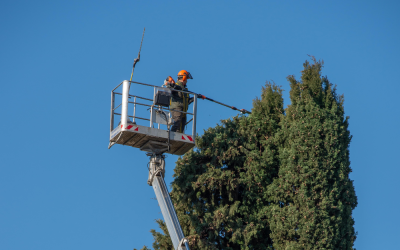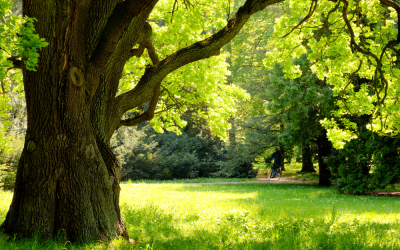Mother Nature can be a force to be reckoned with, and severe storms – which are becoming more and more often in the UK, can wreak havoc on your property. While you can’t control the weather, you can take proactive steps to minimize the damage it inflicts on your trees and home. This blog post will equip you with valuable strategies for storm damage prevention, focusing on safeguarding both your beloved trees and your valuable property.
The Importance of Tree Care for Storm Resilience
Trees are majestic additions to our landscapes, but during storms, they can become vulnerable – or even hazards. However, with proper care, you can strengthen your trees and significantly reduce the risk of storm damage.
Regular Tree Trimming and Pruning is Key
Regular tree trimming is an essential aspect of storm damage prevention. Dead, diseased, or weak branches are more likely to snap under heavy winds and become dangerous projectiles. By removing these problematic branches, you’ll significantly reduce the risk of damage to your home, vehicles, or other property.
Trimming Techniques:
Crown Thinning: This involves selectively removing branches throughout the canopy to allow wind to pass through more easily. Dense canopies act like sails, putting immense stress on the trunk and roots during storms.
Crown Raising: This technique involves removing lower branches to create clearance between the canopy and your home or other structures. This reduces the risk of branches scraping against your roof or siding during high winds.
Deadwood Removal: Dead branches are brittle and offer no structural support to the tree. They’re highly susceptible to breaking off in storms. Regular removal of deadwood is crucial for maintaining a healthy and storm-resistant tree.
Hiring a Certified Arborist:
For proper trimming techniques and to ensure your tree’s overall health, consider hiring a certified tree surgeon. Arborists are tree care professionals with the expertise to assess your trees’ health, recommend appropriate trimming methods, and identify any potential hazards.
Maintaining Healthy Roots for Strong Anchoring
A healthy root system is vital for a tree’s stability and its ability to withstand strong winds. Here’s how to promote healthy root growth:
Proper Watering: Over-watering can weaken roots, while under-watering can stress the tree. Deep watering, allowing water to penetrate the root zone, is essential.
Mulching: Apply a layer of mulch around the base of your trees (keeping it a few inches away from the trunk) to retain moisture, regulate soil temperature, and suppress weed growth that competes with the tree for nutrients.
Aerating Compacted Soil: Compacted soil can restrict root growth. Aeration involves creating small holes in the ground to improve air and water circulation. This can be done with a core aerator or even a garden fork.
Addressing Potential Hazards Before the Storm
Leaning Trees: Leaning trees pose a significant threat during storms. If you have a leaning tree, especially one near your house or power lines, consult with a tree surgeon to determine if it can be saved with cabling and bracing, or if removal is necessary.
Trees with Cavities: Large cavities in the trunk weaken the tree’s structure. An arborist can evaluate the severity of the cavity and recommend appropriate measures, which may include cabling and bracing or tree removal.
Planting Trees Strategically: When planting new trees, consider their mature size and potential impact on structures. Avoid planting trees too close to your home, power lines, or other structures that could be damaged by falling branches.
Protecting Your Property from Storm Damage
While safeguarding your trees is crucial, storm damage prevention extends to your property as well. Here are some key steps to take:
Secure Loose Outdoor Objects: Strong winds can easily turn patio furniture, trampolines, grills, rubbish bins, and other loose objects into dangerous projectiles. Bring them indoors or secure them in a sheltered location before a storm hits.
Inspect and Reinforce Roofs and Gutters: A damaged roof is particularly vulnerable during storms. Check for missing shingles, loose tiles, and any signs of wear and tear. Ensure your gutters are clean and free of debris to prevent water damage from overflowing gutters.
Trim Bushes and Shrubs: Overgrown bushes and shrubs can act as windbreaks, putting additional stress on your home’s structure. Regularly trim them to a manageable size.
Preparing for the Storm’s Aftermath
Even with the best preparation, storms can still cause damage. Here’s what to do after a storm:
Stay Safe: Before venturing outside, check for downed power lines and avoid them at all costs.
Assess the Damage: Once it’s safe to do so, thoroughly inspect your property for damage to your home, roof, trees, and surrounding landscape. Take pictures of the damage for insurance purposes.
Contact Your Insurance Company: Report the damage to your insurance company as soon as possible. They will guide you through the claims process.
Clear Debris Carefully: If there’s fallen debris, be cautious while clearing it. Wear gloves and sturdy shoes to avoid injuries. For large or heavy debris, it’s best to wait for professional help and call a tree surgeon if you have a fallen tree or fallen branches – they will have the right equipment to remove it.
Beware of Downed Power Lines: Downed power lines pose a serious electrical hazard. Never touch them or attempt to move them. Report downed power lines to your utility company immediately.
Document Everything: Keep a detailed record of all expenses related to the storm damage, including receipts for repairs and temporary housing. This will be crucial for your insurance claim.
Seek Help from Professionals: For major repairs to your home or hazardous tree removal, don’t hesitate to seek help from qualified professionals.
By following these storm damage prevention tips, you can significantly reduce the risk of damage to your trees and property during a storm. Remember, an ounce of prevention is worth a pound of cure. By taking proactive steps, you’ll gain peace of mind knowing you’ve done everything possible to weather the storm.



